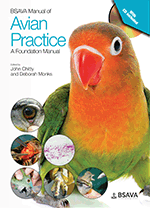
Full text loading...

The small animal clinician looking to expand their remit to include avian medicine requires a large amount of extra knowledge before they are able to provide the same level of primary care that they provide for dogs and cats. This chapter details the practice, personnel, training and CPD, referrals and economic considerations required to become a bird friendly practice.
The bird-friendly practice, Page 1 of 1
< Previous page | Next page > /docserver/preview/fulltext/10.22233/9781910443323/9781910443323.7-1.gif

Full text loading...










